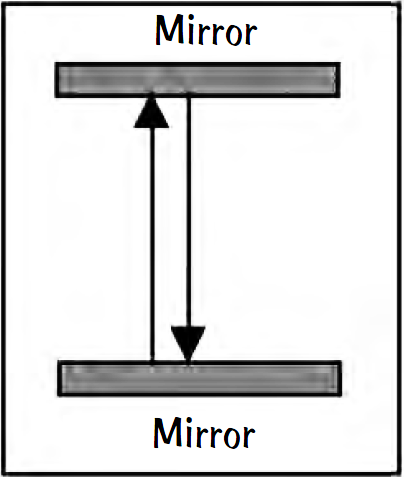


 الفيزياء الكلاسيكية
الفيزياء الكلاسيكية
 الكهربائية والمغناطيسية
الكهربائية والمغناطيسية
 علم البصريات
علم البصريات
 الفيزياء الحديثة
الفيزياء الحديثة
 النظرية النسبية
النظرية النسبية
 الفيزياء النووية
الفيزياء النووية
 فيزياء الحالة الصلبة
فيزياء الحالة الصلبة
 الليزر
الليزر
 علم الفلك
علم الفلك
 المجموعة الشمسية
المجموعة الشمسية
 الطاقة البديلة
الطاقة البديلة
 الفيزياء والعلوم الأخرى
الفيزياء والعلوم الأخرى
 مواضيع عامة في الفيزياء
مواضيع عامة في الفيزياء|
Read More
Date: 25-10-2016
Date: 2-10-2016
Date: 24-11-2016
|
Light Clock
Some museums and laboratories have a light clock with two parallel mirrors and a pulse of light bouncing back and forth repeatedly, retracing the same path over and over, keeping very accurate time as each complete transit of the light pulse is detected and counted. The mirror separation is usually about a meter or less, so a very large number of reflections occur during each second of time. Suppose this light clock is moved sideways parallel to the mirrors at a constant velocity, and assume that the light will continue to reflect off both mirrors during this sideward movement. Will the clock continue to keep accurate time?

Answer
Yes and no. The clock will continue to keep accurate time in both reference frames, in the laboratory frame, and in the rest frame of the clock. But the tick rates will be different. In the frame moving with the clock, the light flashes follow the same path as before, reflecting perpendicularly to each mirror, keeping the same tick rate.

In the laboratory frame, the light continues to reflect off each mirror repeatedly, but during transit from one mirror to the other the path length is longer, being the diagonal of a right triangle. If the speed of light is the same value in both reference frames, then the time interval between reflections (and clock ticks) will be longer in the lab frame now than for the clock at rest. Therefore, a moving clock ticks slower than an identical clock at rest. And this phenomenon is true for all clocks, no matter how they are made. A more complicated situation occurs when the light clock is accelerated parallel to the mirrors. We suggest that you think about this case when there is ample time in your schedule.



|
|
|
|
علامات بسيطة في جسدك قد تنذر بمرض "قاتل"
|
|
|
|
|
|
|
أول صور ثلاثية الأبعاد للغدة الزعترية البشرية
|
|
|
|
|
|
|
مكتبة أمّ البنين النسويّة تصدر العدد 212 من مجلّة رياض الزهراء (عليها السلام)
|
|
|